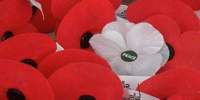W is for War, or refusing to fight it.
27/04/16 07:57
Again a huge topic so this will concentrate on the legislation surrounding WWI.
It soon became apparent that the need for servicemen would not be met by volunteers so the Milirary Service Act 1916 introduced conscription for single men aged 18-41. I wonder if this led to a rash of marriages in an attempt to avoid service.
There were exemptions for those medically unfit to serve, for clergymen (many of whom allegedly urged their parishioners to sign up), teachers and certain protected occupations. This led to numerous challenges to conscription on the grounds that their occupation was protected. Locally this centred on what was a 'shoe' and what was a 'slipper', shoe workers were exempt as they could make boots but slippers were designated luxury items and their workers had to fight. In one case the recruiter argued that velvet shoes were a luxury and the individual argued, successfully, that they were made to be worn outdoors and so constituted a shoe.
It also introduced certificates of exemption for conscientious objectors, of which Springhill with its Quaker and Baptist influences had plenty. Conchies fell into three main groups:
Nationally,approx 16,000 applied, most of those who were successful were Quakers. The minister at Sion Baptist at the time, Rev J Barton Turner, was accused of running classes prior to the tribunals of men applying for conscientious objection. At his hearing he denied stating that it 'didn't matter whether Britain was ruled by King or Kaiser'. Around 3,400 accepted Non-Combatant Corps or RAMC, these were given rank, number and uniform.
In May 1916 Military Aervice Act was amended to include married men (so any rush to marry didn't work for long) and in April 1918 it was further amended to include all men between 17 & 55 in conscription.

Organisations supporting conscientious objectors included
Fellowship of Reconciliation www.for.org.uk formed 1914 to 'promote non violence as a personal, social, economic and political transformation'
Peace Pledge union www.ppu.org.uk, also no more war project www.ppu.org.uk/nomorewar/index.html. John Hart of Polefield Cottage left a legacy to the Peace Pledge Union.
No-conscription Fellowship, formed 1914 by Fenner Brockway and Clifford Allen to support conchies
It soon became apparent that the need for servicemen would not be met by volunteers so the Milirary Service Act 1916 introduced conscription for single men aged 18-41. I wonder if this led to a rash of marriages in an attempt to avoid service.
There were exemptions for those medically unfit to serve, for clergymen (many of whom allegedly urged their parishioners to sign up), teachers and certain protected occupations. This led to numerous challenges to conscription on the grounds that their occupation was protected. Locally this centred on what was a 'shoe' and what was a 'slipper', shoe workers were exempt as they could make boots but slippers were designated luxury items and their workers had to fight. In one case the recruiter argued that velvet shoes were a luxury and the individual argued, successfully, that they were made to be worn outdoors and so constituted a shoe.
It also introduced certificates of exemption for conscientious objectors, of which Springhill with its Quaker and Baptist influences had plenty. Conchies fell into three main groups:
- non combatants - sign up but non arms bearing
- alternativists - work not involving military control
- abolitionists - no service supporting the war
Nationally,approx 16,000 applied, most of those who were successful were Quakers. The minister at Sion Baptist at the time, Rev J Barton Turner, was accused of running classes prior to the tribunals of men applying for conscientious objection. At his hearing he denied stating that it 'didn't matter whether Britain was ruled by King or Kaiser'. Around 3,400 accepted Non-Combatant Corps or RAMC, these were given rank, number and uniform.
In May 1916 Military Aervice Act was amended to include married men (so any rush to marry didn't work for long) and in April 1918 it was further amended to include all men between 17 & 55 in conscription.

Organisations supporting conscientious objectors included
Fellowship of Reconciliation www.for.org.uk formed 1914 to 'promote non violence as a personal, social, economic and political transformation'
Peace Pledge union www.ppu.org.uk, also no more war project www.ppu.org.uk/nomorewar/index.html. John Hart of Polefield Cottage left a legacy to the Peace Pledge Union.
No-conscription Fellowship, formed 1914 by Fenner Brockway and Clifford Allen to support conchies




